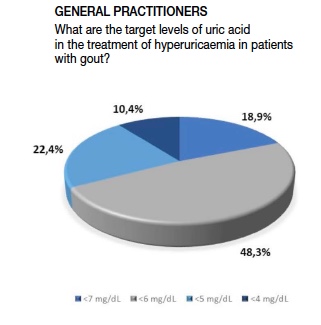Understanding and perceptions of gout: an interdisciplinary assessment among patients, physicians and pharmacists in Italy

Submitted: 29 March 2019
Accepted: 17 December 2019
Published: 10 April 2020
Accepted: 17 December 2019
Abstract Views: 1197
PDF: 786
Publisher's note
All claims expressed in this article are solely those of the authors and do not necessarily represent those of their affiliated organizations, or those of the publisher, the editors and the reviewers. Any product that may be evaluated in this article or claim that may be made by its manufacturer is not guaranteed or endorsed by the publisher.
All claims expressed in this article are solely those of the authors and do not necessarily represent those of their affiliated organizations, or those of the publisher, the editors and the reviewers. Any product that may be evaluated in this article or claim that may be made by its manufacturer is not guaranteed or endorsed by the publisher.
Similar Articles
- G. Pasero, P. Marson, Short story of antirheumatic therapy.VIII. The immunodepressants , Reumatismo: Vol. 64 No. 1 (2012)
- M. Manara, A. Bortoluzzi, M. Favero, I. Prevete, C.A. Scirè, G. Bianchi, C. Borghi, M. A. Cimmino, G. M. D'Avola, G. Desideri, G. Di Giacinto, M. Govoni, W. Grassi, A. Lombardi, M. Marangella, M. Matucci Cerinic, G. Medea, R. Ramonda, A. Spadaro, L. Punzi, G. Minisola, Italian Society of Rheumatology recommendations for the management of gout , Reumatismo: Vol. 65 No. 1 (2013)
- F.M. Perrotta, E. Lubrano, New approved drugs for psoriatic arthritis , Reumatismo: Vol. 68 No. 2 (2016)
- P. Marson, G. Pasero, Some historical remarks on microcrystalline arthritis (gout and chondrocalcinosis) , Reumatismo: Vol. 63 No. 4 (2011): Special issue • Microcrystalline Arthritis
- M. Bellan, P.P. Sainaghi, M. Pirisi, The real evidence for polymyalgia rheumatic as a paraneoplastic syndrome , Reumatismo: Vol. 70 No. 2 (2018)
- M. Rossini, G. D'Avola, M. Muratore, N. Malavolta, F. Silveri, G. Bianchi, B. Frediani, G. Minisola, M. L. Sorgi, M. Varenna, R. Foti, G. Tartarelli, G. Orsolini, S. Adami, Regional differences of vitamin D deficiency in rheumatoid arthritis patients in Italy , Reumatismo: Vol. 65 No. 3 (2013)
- F. Lioté, Treatment of hyperuricemia, gout and other crystalline arthritidies , Reumatismo: Vol. 63 No. 4 (2011): Special issue • Microcrystalline Arthritis
- M. Manara, A. Bortoluzzi, M. Favero, I. Prevete, C.A. Scirè, G. Bagnato, G. Bianchi, M. Ceruso, G. A. Checchia, G. M. D'Avola, G. Di Giacinto, B. Frediani, A. Lombardi, A. Mannoni, G. Mascheroni, M. Matucci Cerinic, L. Punzi, P. Richelmi, M. Scarpellini, F. Torretta, A. Migliore, R. Ramonda, G. Minisola, Italian Society for Rheumatology recommendations for the management of hand osteoarthritis , Reumatismo: Vol. 65 No. 4 (2013)
- G. Turchetti, S. Bellelli, M. Mosca, The social cost of rheumatoid arthritis in Italy: the results of an estimation exercise , Reumatismo: Vol. 65 No. 6 (2013)
- S. Russo, T. T. Mariani, R. Migliorini, A. Marcellusi, F. S. Mennini, The economic burden of musculoskeletal disorders on the Italian social security pension system estimated by a Monte Carlo simulation , Reumatismo: Vol. 67 No. 2 (2015)
You may also start an advanced similarity search for this article.
Publication Facts
Metric
This article
Other articles
Peer reviewers
2
2.4
Reviewer profiles N/A
Author statements
Author statements
This article
Other articles
Data availability
N/A
16%
External funding
N/A
32%
Competing interests
N/A
11%
Metric
This journal
Other journals
Articles accepted
39%
33%
Days to publication
377
145
Indexed in
-
—
- Academic society
- N/A

 https://doi.org/10.4081/reumatismo.2020.1227
https://doi.org/10.4081/reumatismo.2020.1227





